| I cannot claim authorship of the piece reproduced here, though I did contribute to its composition under the pen of Peter Wootton Beard. It recently appeared as a tribute from the Vice Chancellor, Elizabeth Treasure, in the inboxes of all university staff. John Corfield was ubiquitous in Aberystwyth, some knew him best for his work at the exceptionally fine gardens of the Penglais campus, others for the panache with which he received bucket loads of wallpaper paste down the trousers in the Wardens’ pantomimes. I reproduce the tribute here in full, but have augmented it with a number of photographs charting his life. It is with a heavy heart that I share the news with you that our former Head Gardener John Corfield passed away peacefully on 15th August 2020. He will be hugely missed. John was born shortly after his parents moved from Montgomeryshire to Tan-y-Castell farm, Llanfarian in 1933, where his father became the tenant farmer of the Tan-y-Bwlch estate. After a terrible flood in 1964, the family were forced to leave the farm and moved to Marian House, Llanfarian. 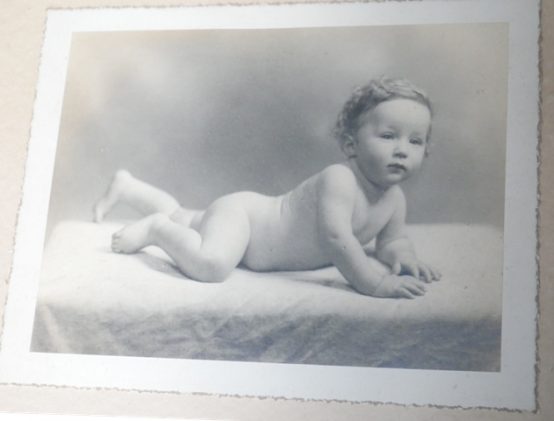 John Corfield. Portrait by H.N. Davies of Aberystwyth 1934 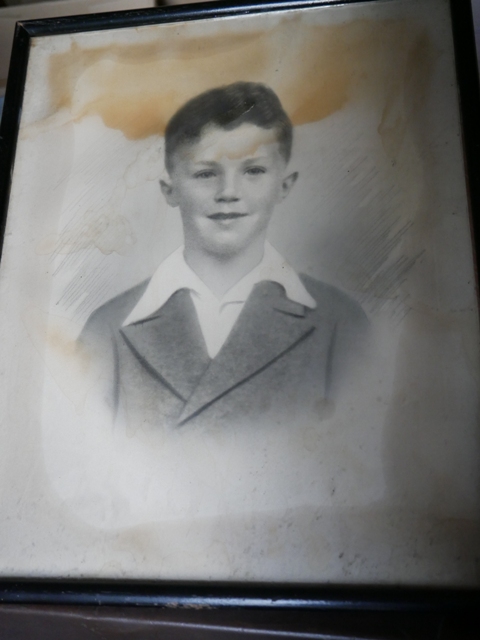 The schoolboy John, in a photograph re styled as a pencil drawing John subsequently joined the University staff under the newly appointed Curator of the Botany Gardens and College Grounds, Basil Fox, and under the direction of Prof. Philip Wareing, then Head of Botany shortly thereafter. The team were responsible for taxonomic order beds adjoining Plas Penglais, the provision of plants for the undergraduate practical classes and research programmes, as well as the management of small-scale field experiments for the Botany and Agricultural Botany departments of University College Wales. Their role expanded to include the planting of the new Penglais Campus. The campus rapidly expanded over the next twenty years and between them, John and Basil were responsible for introducing a wide range of plants that are perfectly suited to the exposed coastal conditions. John became Head Gardener in 1983, amply filling the rather large shoes vacated by his predecessor, Basil Fox. The gardens were highly praised by Arthur Hellyer in the 1970s and were awarded a Grade II listing in the Cadw Register of Landscapes, Parks and Gardens of Special Historic Interest in Wales in 2002. The listing describes them as ‘One of the most important modern landscaping schemes in Wales’. John worked with the renowned landscape designer Brenda Colvin overseeing the planting between Pantycelyn and the main campus and was instrumental in bringing her vision to fruition. It is perhaps a little known fact that we work in such a special landscape, but I’m sure we all appreciate the beautiful surroundings that greet us when we come in to work, and we have John to thank for much of that. The current grounds team, under the management of Jeff Saycell, are working hard to restore elements of the original landscape and to protect John’s legacy. John became a formidable botanist; whose breadth of knowledge and interests were honed on his many botanical excursions with friends and colleagues to locations such as Greece, Crete, and the Pyrenees. On such occasions he demonstrated his considerable skill with languages, regularly surprising people with his ability to get about comfortably in Greek, Turkish, German and others.
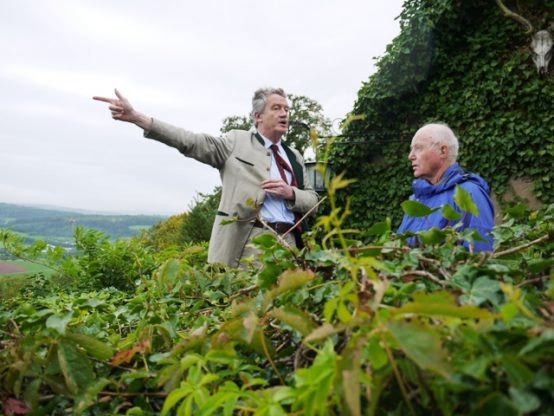 In Germany with Count Constantin von Brandenstein
His expertise was often called upon for the student trips organised by the Botany department to the Picos de Europa mountain range in Cantabria, Northern Spain. His colleagues at the time describe John as a ‘magnet’ for students during these 8-10 day trips under canvas, due to his vast botanical knowledge, patience and warmth of personality. 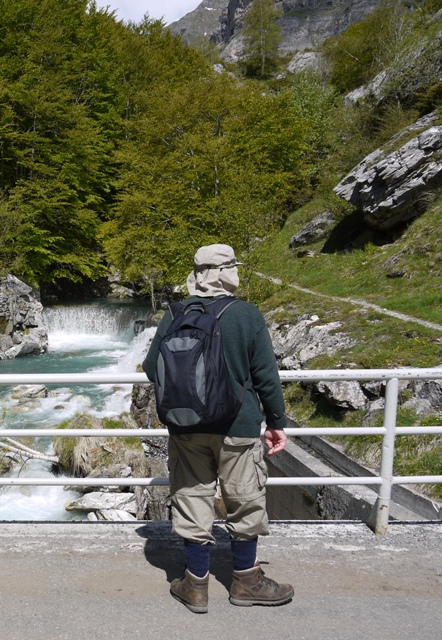 In field gear in the Pyrenees Maintaining academic standards in this environment required considerable ingenuity, and John was a great source of strength – making camp furniture, mentoring projects and monitoring student submissions. He was able to form a connection with anyone and everyone he met and inspired a generation of botany students. He wrote to his friend and former colleague Andrew Agnew just eight days before his passing to reminisce about how much he enjoyed the trips to the Picos de Europa, a memory that Andrew was pleased to share. He was also often called upon to share his passion through talks and practical advice to the local community. 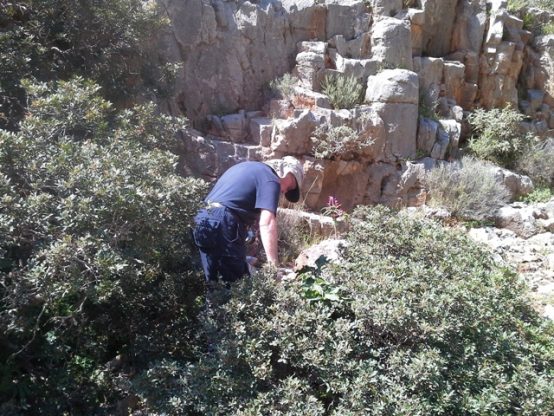 Botanizing in Crete 2015 He was a founder member of the Cardiganshire Horticultural Society, formed in 1968, and following Basil Fox’s death in 1983, became the second President of the society, a post he filled until its 50th anniversary in 2018. Today the society has over 150 members, a tribute to the energy and warmth that John brought to every meeting. 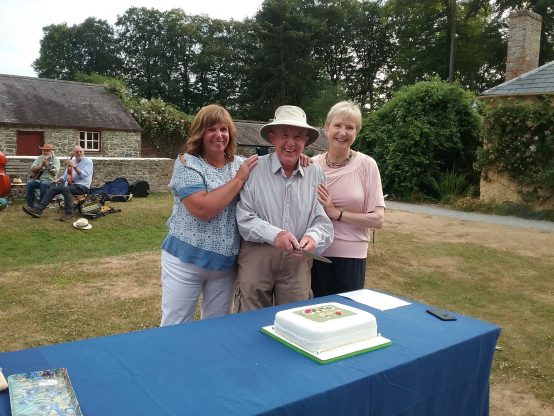 The Cardiganshire Horticultural Society turned 50 in 2018. President John Corfield with Jan Eldridge and Kay Edwards who helped cut the cake. So many members of the society have plants given by John in their gardens, and he was well known for his generosity that would lead him to lovingly raise seedlings at his home, with the express purpose of bringing joy to those who would subsequently receive them as an impromptu gift. He had just told me that he was growing a Koelreuteria paniculata (Golden Rain Tree) for me at the time of his passing, and I can think of no better way to remember him. Prof. Mike Hayward remarked that a cyclamen grown for him by John came into flower on the day of his passing, a lasting gift that so many of his friends will be able to enjoy for years to come. John was also a keen thespian and a founder member of the relaunched ‘Wardens Amateur Dramatic Society’. He was involved with nearly every show since the early 1980s as, variously, stage management, performer & front of house. He was also involved in many productions by Showtime Singers. 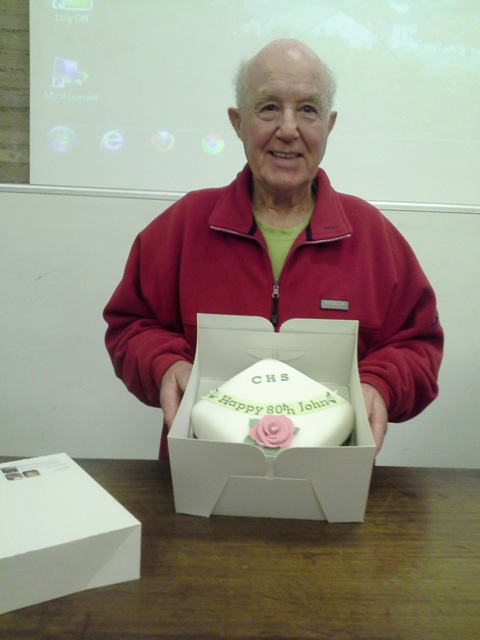 The Cardiganshire Horticultural Society celebrated their President’s 80th birthday in 2013 A private funeral took place at John’s green burial on 27th August, where only a small number could be present due to Covid-19 restrictions. We hope to celebrate John’s life in fitting style in due course within the Horticultural Society, and I will circulate details of any subsequent event for staff/former colleagues who may wish to attend nearer the time. We also hope that a memorial tree for John will soon be planted on the campus, details of which will be shared in due course. Thanks to John’s friends, family and former colleagues for their help in preparing this tribute: Tom Corfield, Matthew Piper, Dr Andrew Agnew, Pat Causton, Margaret Howells, Prof. Mike Hayward, Dr Caroline Palmer, Dr Edwina Ellis, and Penny David. My thanks to Dr Peter Wootton-Beard for his working in preparing this wonderful piece in memory of John Corfield. Professor Elizabeth Treasure |
Author Archives: Curious Scribbler
Justina Jeffreys – Black History
By The Curious Scribbler
During the ennui of lockdown I have been researching a little piece of Ceredigion’s black history.
My subject was Justina Jeffreys of Glandyfi castle, that eccentric Regency Gothic castle which perches above the (now straightened) Glandyfi Bends on the way to Machynlleth. It was built in 1818 as the fashionable designer home of Shrewsbury born lawyer George Jeffreys and his new bride Justina Scott. Justina had grown up at Bodtalog, a small country house near Tywyn, as the child of the bookish intellectual Edward Scott and his wife, the widow Louisa de Saumaise. It has long been believed that she was the model for Anthelia the heroine of Thomas Love Peacock’s first novel Melincourt. Anthelia is described as a highly rational young woman brought up and educated in solitude by a man of ‘great acquirements and of a retiring disposition’.
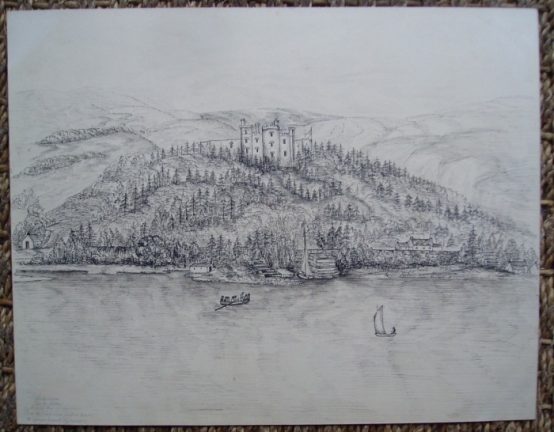
Glandyfi castle sketched by Francis Wood in 1838
But all was not as it seems, for Justina was not born a Scott. She was born in Jamaica in 1787 the daughter of the premier army man then posted to the island, Captain Charles McMurdo of the 3rd East Kent Regiment “the Buffs” and a young woman called Susan Leslie. In the eighteenth century colonies bastardy was a very common phenomenon, on most pages of the parish birth records the children born in wedlock are the exception rather than the rule. I cannot believe that the church actively approved of this situation but its clergy were diligent in recording the facts. Fathers are normally named, and race and status was a matter of record.
So we know that Susan Leslie was a free mulatto, who underwent baptism in the Anglican church at the same time as her new daughter. A mulatto is a specific term, it means she had one black parent, and given the social structure of the slave economy it is highly likely that that black parent was a woman and a slave.
Justina’s conception was more than a one night stand, for two years later her brother was born, also sired by Captain McMurdo, and named Charles McMurdo.
There might have been more illegitimate McMurdos were it not for the fact that Captain McMurdo’s posting in Jamaica came to an end, and he was sent off to Canada, where he eventually married a well connected young woman from a loyalist family, named Isabella Coffin and started a second family. His first legitimate son was named Charles Alured McMurdo (the unusual second name being a nod to the Governor of Jamaica, Alured Clarke under whom McMurdo had served).
Susan Leslie remained in Jamaica, and must, I believe, have been a handsome and sought-after young woman. She was soon the partner of a Scottish doctor, John Wright by whom she had two more sons. She was, or in her lifetime became, a woman of property for her will, written on a visit to London in 1801, distributes her land, buildings and slaves among her three sons, and names both the fathers as executors of the will.
It is touching that in the will she leaves to Justina her ‘apparel, trinkets and her silver spoons’. In a subsequent codicil she rescinds these small gifts because her daughter has been amply provided for by McMurdo. So how had McMurdo provided?
Justina had been removed from her mother and ‘adopted’ by Edward Scott, who during the Jamaica years had been Captain McMurdo’s junior officer, First Lieutenant in the same regiment. Edward, an impecunious younger son of an aristocratic Kent family had no children of his own, but when Justina was just three years old he had married, possibly for money, the wealthy widow Louisa, who happened to be the widow of his first cousin Count Louis de Saumaise. It was through Louisa, daughter of welshman Lewis Anwyl, that he winded up living comfortably as the squire of Bodtalog with Louisa and Justina. I would speculate that when Justina was five or six years old she was shipped off to her new ‘uncle’. She must have been quite young to have been so well educated and nurtured as a Welsh gentlewoman, but not so young that her brother Charles did not remember her. While there is no evidence that the siblings met again, by the age of 20 Justina’s brother Charles McMurdo was in Limehouse, London founding a family of several generations of boat builders. He and his descendants repeatedly named their daughters Justina.
Although Justina is named as Justina Scott in the marriage register her paternity was no secret, it was known to the Jeffreys family into which she married, and her birthplace, Jamaica, is recorded in the census. Her high-status white father, McMurdo, would have been a matter of pride rather than shame, just as Mary Seacole, who we now venerate for her blackness, was openly proud of her Scottish military father. Justina’s story reminds me of other examples of the rapid social mobility of the mixed race offspring English and Welsh gentlemen in the eighteenth century. The purchaser in 1803 of the Piercefield estate near Chepstow, for example, was Nathaniel Wells the Jamaican-born natural son of William Wells, his offspring by a house slave known as Juggy. Nathaniel’s origins did not hold him back, he became the high sheriff of Monmouthshire.
George and Justina seem to have enjoyed a nice life in their pretty castle, and produced eight children all baptised at Eglwysfach church, where her old admirer Thomas Love Peacock also showed up to marry Jane Gryffydh in 1820. Justina’s relationship with her adoptive parents also seems to have been good, two of her children bear the names Edward and Louisa, and when the very elderly Edward Scott eventually died aged 90 his estate, barring various legacies, was placed in trust for Justina for her lifetime.
Glandyfi castle first went on the market in 1906 when it was sold by two of Justina’s granddaughters. Several lines of descent from George and Justina have been extinguished in later generations, but some persist in New Zealand and America, and have been known to turn up on holiday to visit the castle. Today it is for sale once more for £2.85million.
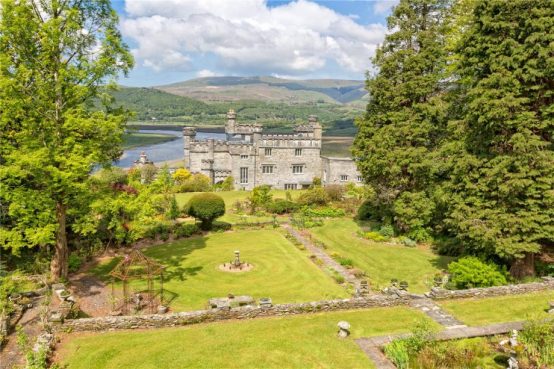
Glandfi Castle sale particulars in Country Life 2020
The full story of my researches have been accepted for publication in Ceredigion, the Journal of the Ceredigion Historical Society and will appear in 2022.
Black History: John Ystumllyn and Scipio Kennedy
by The Curious Scribbler
I recently visited the tiny rural church of St Cynhaearn, which stands within a circular graveyard in the middle of nowhere between Porthmadog and Criccieth. Worshipers must have walked to it from Pentrefelin and from isolated farms but when you stand at the church there is not a single house in view. Little wonder then that it is now in the care of the Friends of Friendless Churches. Fortunate for this lonely church and fortunate also for me, because since Covid the active churches have been strangely unwilling to leave their doors open. Friends of Friendless churches are the exception: they remain open all the time.
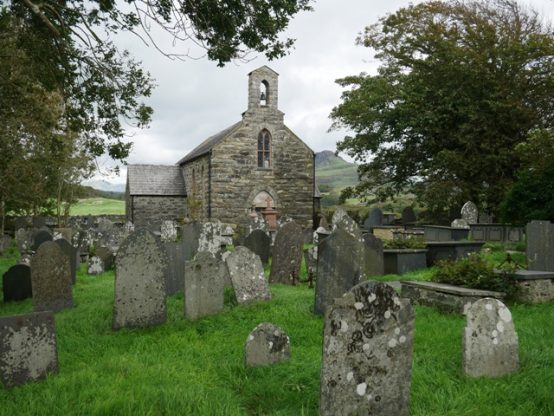
St Cynhaearn, Ynyschaearn
One objective was to see the grave of one of Wales’ early black inhabitants, John Ystumllyn, (1740-1786) who lies buried in the graveyard. His stone was soon located to the left of the path, propped against one of the many 19th century slate chest tombs. It seemed startlingly new-looking, clear even of encrusting lichen, but I suppose this is because it has recently been re-cut.
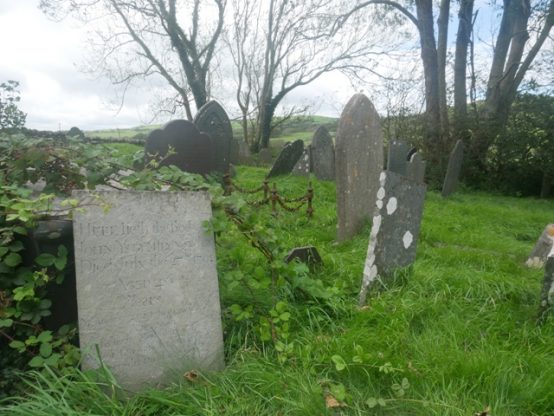
John Ystumllyn’s grave at St Cynhaearn
As I looked around it was clear that the eighteenth century memorials were carved on a locally sourced pale stone, quite different from the dark grey Penrhyn slates produced in the 19th century. The old local stones are not deeply incised and for the most part are barely legible. John’s fame perhaps justifies the facelift to the gravestone, but some of the romance has been lost with the restoration.
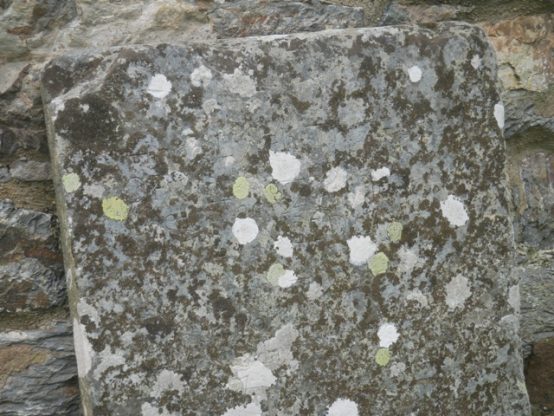
An unrestored eighteenth century gravestone in St Cynhaearn Church
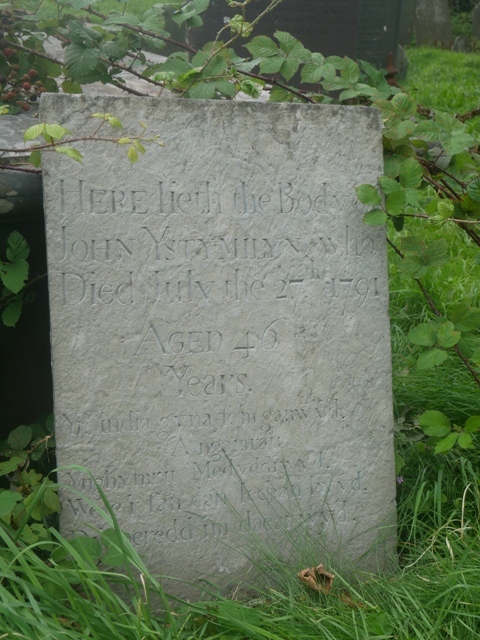
Recut gravestone of John Ystumllwyn at St Cynhaearn’s Church
John’s life story was published in a welsh pamphlet by local bard Alltud Eifion of Tremadoc in 1888 and can be read in translation by Tom Morris 1971. The story is retold by Andrew Green in his blog Gwallter in 2017. According to an oral history originating from John himself, he was a child trying to catch a moorhen by a woodland stream when he was captured by white men who took him away to their yacht. His mother ran after them yelling in protest. It seems highly unlikely to me that he was ever a slave in the West Indies. He was simply captured in his native land to supply the fashion for a black servant in the grand houses of 18th century Britain. Such a trophy is best caught young to be trained for his new life. The account goes on to say that, on being added to the household of Ellis Wynne of Ystumllyn, he had no language and communicate only in howls and screams.

Ystumllyn, seat of the Wynnes in 1794 by John Ingleby
More likely he had no language that could be understood by his captors, for he seems to have been an intelligent boy. Alltud Eifion wrote: They had considerable difficulty for a long time in domesticating him, and he was not allowed to go out; but after some efforts by the ladies, he learnt both languages, and he learnt to write; then he was placed in the garden to learn horticulture, which he did more or less perfectly, as he was very ingenious.
In keeping with the status which their slave boy conferred, the family had his portrait painted and he is shown as a handsome young man.  The local girls certainly thought so, and are said to have competed for the favours of the exotic gardener. One such was Margaret Gruffydd, another servant in the household who later moved to a job near Dolgellau. Having run away to get married to her, John lost his post at Ystumllyn but the two were clearly employable: living at Ynysgain Fawr they produced two sons and five daughters, but eventually moved back to work for the Wynnes at Ystumllyn. He died quite young, suffering from jaundice, aged 46. The pamphlet identifies the marriages of several of his daughters, who may well have descendants today. One son, named Richard, grew to adulthood and became Lord Newborough’s Huntsman at the Glynllifion estate. He is remembered as a ‘tall, calm man, who wore a Top Hat, Velvet Coat with a high white collar around his throat’. He had a family and lived to the age of 92.
The local girls certainly thought so, and are said to have competed for the favours of the exotic gardener. One such was Margaret Gruffydd, another servant in the household who later moved to a job near Dolgellau. Having run away to get married to her, John lost his post at Ystumllyn but the two were clearly employable: living at Ynysgain Fawr they produced two sons and five daughters, but eventually moved back to work for the Wynnes at Ystumllyn. He died quite young, suffering from jaundice, aged 46. The pamphlet identifies the marriages of several of his daughters, who may well have descendants today. One son, named Richard, grew to adulthood and became Lord Newborough’s Huntsman at the Glynllifion estate. He is remembered as a ‘tall, calm man, who wore a Top Hat, Velvet Coat with a high white collar around his throat’. He had a family and lived to the age of 92.
The story has close parallels with that of one of my great great great great great great grandfathers, Scipio Kennedy. He too was a child captured in Africa, and he was brought to Scotland by a sea captain, as a gift for his daughter. This was some fifty years before John’s experience. Captain Andrew Douglas of Mains was not a captain in the transatlantic slave trade, but a naval officer, commander of a 60 gun warship which accompanied a convoy to Jamaica in 1702 and returned in 1704. He bought the young boy in Jamaica aged about seven and brought him back to his home.
Culzean in Scipio’s time
Three years later, when the captain’s daughter married John Kennedy, eldest son of Sir Archibald Kennedy of Culzean castle, Scipio was part of her dowry, and took the surname of Kennedy. In 1710, Sir John and his wife inherited Culzean castle, where Scipio was to spend his adult life.
Much is known about Scipio, (he has his own entry in the Oxford Dictionary of National Biography and a wikipedia page – he is Ayrshire’s first known black inhabitant). Sir John and Lady Jean invested ‘in his clothing maintenance and education’ and by his mid twenties he was a Christian, could read and write, and worked at Culzean. As a Christian he was now deemed a free man and in 1725 he signed a nineteen year contract to continue his employment with Sir John. This may well have included gardening, for Sir John was exceptionally keen on horticulture.
Like John Ystumllyn, Scipio was popular with the local girls, and in 1727 was severely reprimanded by the Kirk for fornication with another estate servant, Margaret Gray, who bore his child. They married in 1728, and had seven more children. The multi-talented Scipio served as butler in the Castle, and coordinated in his master’s extensive smuggling activities. He and his wife also wove and sold cotton and linen goods. In 1744 Sir Thomas Kennedy succeeded his father and built a substantial stone house for Scipio on a large plot in the grounds of the castle, the site of which has recently been excavated by the National Trust. Scipio was now smuggler, weaver and cook at the castle.

Estate survey showing Scipio’s house and land at Culzean (Image National Trust for Scotland)
Scipio and Margaret’s eldest son Douglas continued in the family’s service and became the body servant of Sir John’s son Thomas Kennedy, accompanying him on his many European tours. Scipio lived to the age of 80 and is buried in Kirkoswald churchyard and a stone was erected in his memory by his son Douglas, who is also buried there.
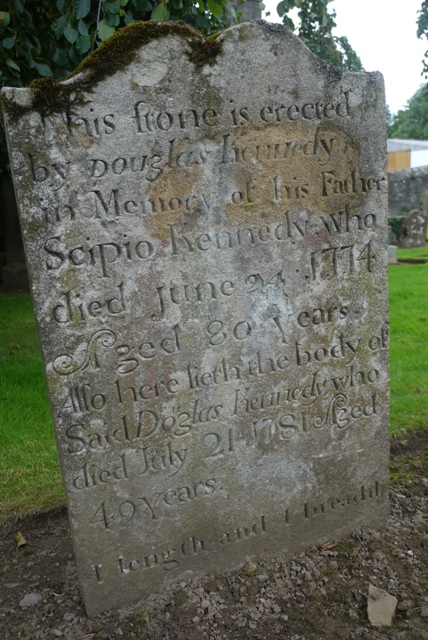
Monument to Scipio Kennedy in Kirkoswald churchyard, erected by his son Douglas.
The National Trust at Culzean has issued a long series of blogs which agonize from today’s perspective as to the unknowable questions: Was Scipio oppressed? Was he unhappy? Did manumission significantly improve his life? Scipio’s manumission document rehearses his life story, in which he represents himself as very fortunate: ‘for as much as in my infancy I was bought and redeemed by Captain Douglas .. and was in a certaine way of being in perpetual servitude in the West Indies had it not been my happiness to fall into his hands purchased by his money with whom I remained for three years or thereabouts. At which time I was presented to Sir John and his lady …’
It was a lifelong commitment and when Lady Jean died in 1751, she left ‘to Scipio Kennedy my old servant, the sum of ten pounds sterling’ – which was the same sum she had earmarked for each of her grandchildren.
Scipio Kennedy and John Ystumllyn seem to have made a considerable success of their rudely transplanted lives.
A perfect day for Pendinas
By The Curious Scribbler
It is hard to remember last week’s grey shrieking storm. Yesterday I walked up Pendinas in balmy sunshine, and a gentle breeze. The sea looked as blue as the Mediterranean and the recently turbulent ocean is now calm and translucent – one can see the dark shadows of clouds upon the water, but also the shaded blotches of underwater outcrops of rock under the sea. Looking over towards Alltwen, the black cattle were all grazing on the flat land. Some mornings they are spread right up the hillside above the woods which enfold Tanybwlch mansion. There is a grandeur in seeing the cattle spread out like wild things in this huge landscape, not penned in a modest field of monocultural grass. The flats are no longer the scene of the trotting races, but viewed from Pendinas one can still see the ghost of the grass track, subtly darker, perhaps better fertilized, than the rest of the meadow.
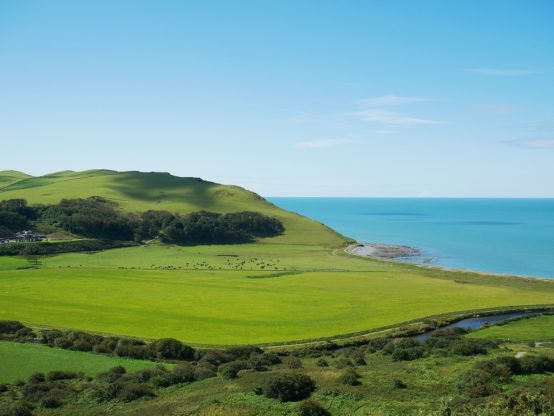
Alltwen and the Tanybwlch flats viewed from Pendinas
The climb is a prolonged one, even from the ‘easy’ access at the top of Cae Job in Penparcau. Families toiled up the path to the iron age hillfort, topped with Victorian arrogance by the chimney-like monument to Wellington’s victory at Waterloo.
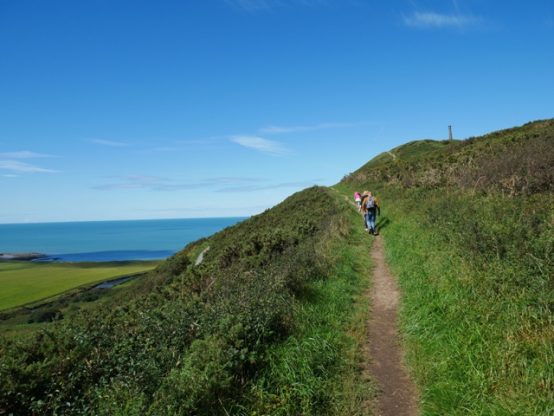
The path up from Cae Job
At least that is what it ostensible is. Personally I think of it more as a monument to a local gentleman, William Eardley Richardes of Bryneithin Hall who built it in 1856 and invited subscriptions from the town. It is no coincidence how grandly it adorns the landscape as viewed from the windows of his mansion to the south. The victory at Waterloo was in 1815, and I would have thought that by 1856 national fervour for a monument would have somewhat abated. Richardes himself had been in the army of occupation after Waterloo, and was moved to re-name the five fields around his house General, Governor, Captain, Lieutenant, and Major! They appear thus on the tithe survey of 1848.
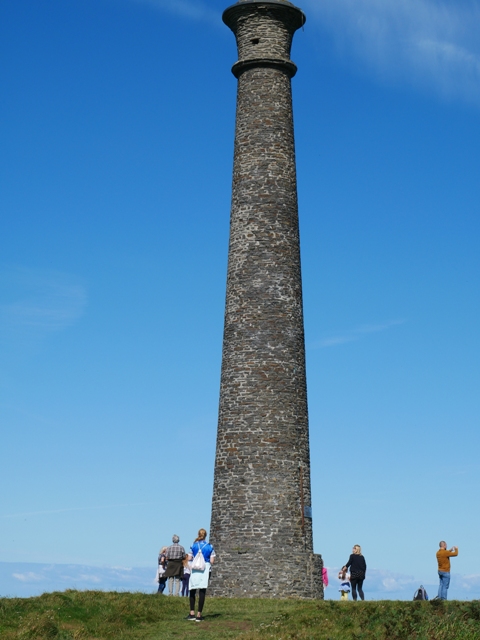
The wellington memorial on Pendinas
There were quite a few people at the top, typically facing in all different directions! The 360 degree panorama laid out before us has no weak point. Take your pick for views of the harbour and the sea and the distant Lleyn Peninsula, Penglais Hill punctuated by the Hospital, the National Library and University of Aberystwyth, or Penparcau spread out around its green-roofed 20th century primary school.
I first sat on the seaward side, where the bracken and gorse given way to heather and coarse grass. A wren fidgeted around a dead tree stump below me, and the honey bees came in waves, sometimes there were none, then quite suddenly thirty or more were working their way through the flowers beside me, then disappearing back to the hive. This is a great spot for looking down on flying birds: red kite, herring gulls, soaring the thermals, crows sculling steadily across the fields. Four speed boats came south into my view leaving white trails of wake. When they gingerly slowed to creep into Aberystwyth harbour at low tide I could see underwater the bar which partly occludes the harbour mouth.
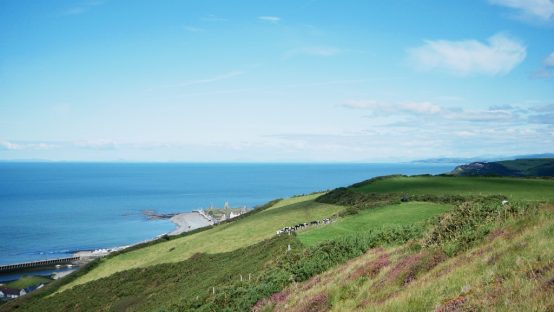
Aberystwyth Castle just visible from Pendinas
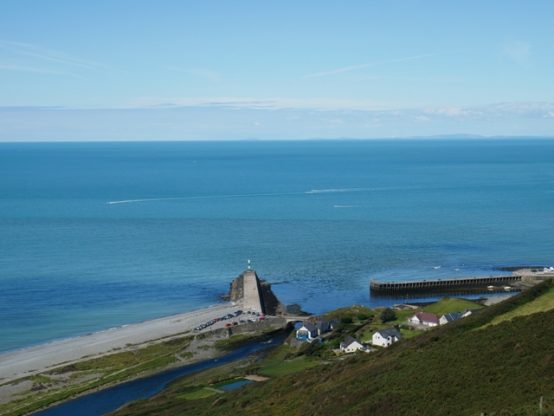
Speedboats approach Aberystwyth Harbour
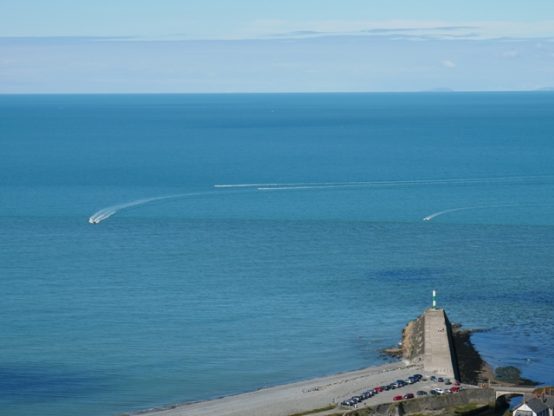
It may be a Bank Holiday during a pandemic but there is space and beauty for all to enjoy. Looking down, one could see around twenty cars parked at Tanybwlch beach now that the concrete barriers have been cleared away. There has always been more than enough space for social distancing on that beach, and I am glad to see these unnecessary restrictions have been removed.
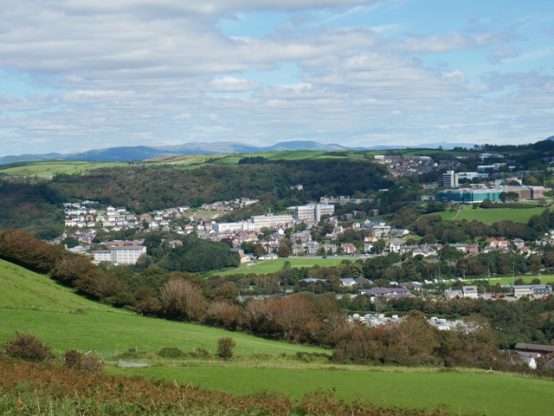
Penglais Hill, Aberystwyth, viewed from Pendinas
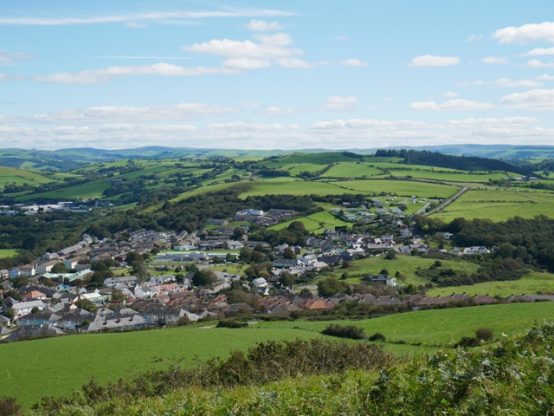
Penparcau, viewed from Pendinas
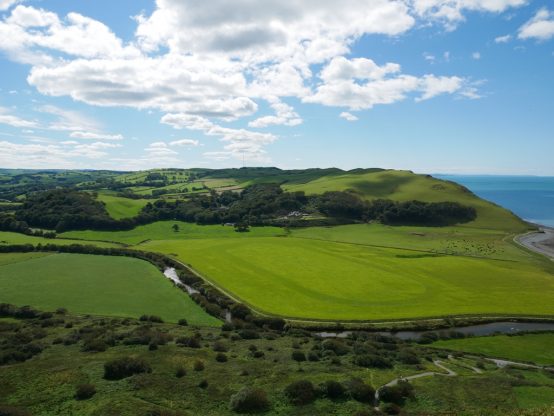
The view south from Pendinas
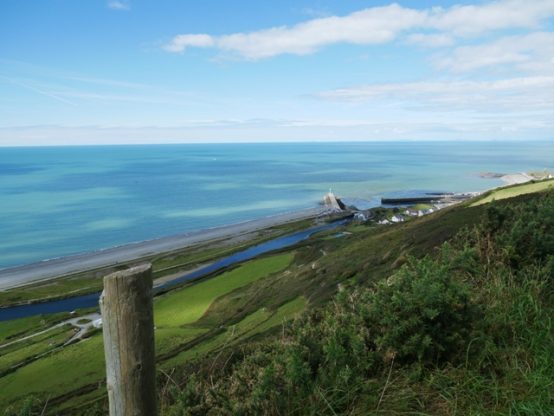
The Ystwyth enters the harbour at Penyranchor
I love a storm!
by The Curious Scribbler
Rain last night has further swollen the rivers, and now we have wind! Exhilarating buffeting winds from the west, gusting almost hard enough to knock you over! 60 miles an hour or so I’m told. So my place of choice is Tanybwlch, where the Ystwyth debouches into the sea. It is murky and brown with fresh run off, and further swollen in the tidal reach because the tide is obstructing its outward flow.
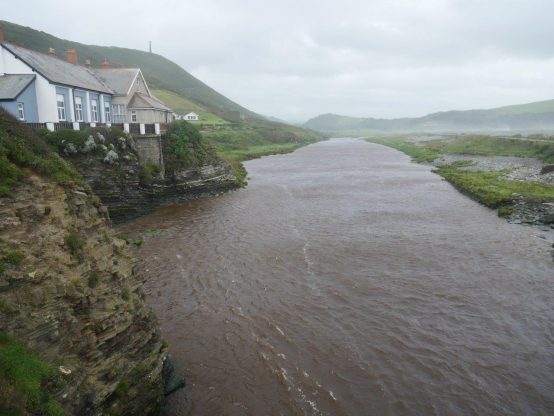
High seas back up the Ystwyth river
Mist from the breakers hangs over the Tanycastell fields and the riverside path is flooded in parts.
The concrete jetty largely protects the harbour mouth, though the swell still forms regular brown rollers creeping along its leeward side.
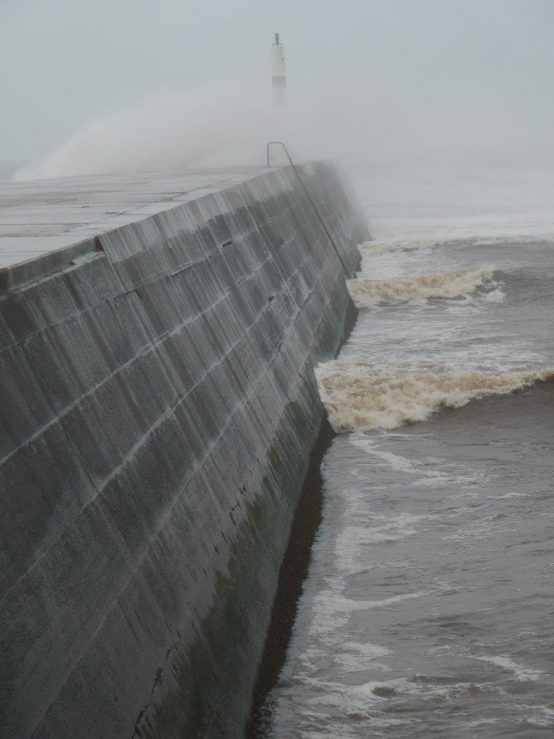
The stone jetty protects the harbour from the south westerlies but some waves roll in
But to position yourself on the windward side on the top of the shore provides an endless spectacle, as waves break in curious explosive shapes over the green and white harbour marker, sometimes obscuring it from view, and the backwash forms swirling wave patterns in the angle between the beach and the shore. It is easy to see how the huge stones at this end of the beach get their smooth contours. The sea acts like a giant pebble-polishing device.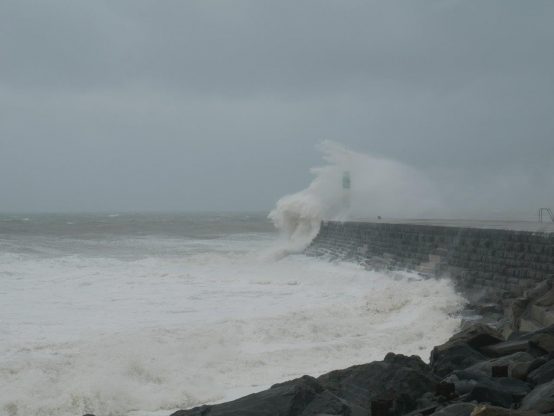
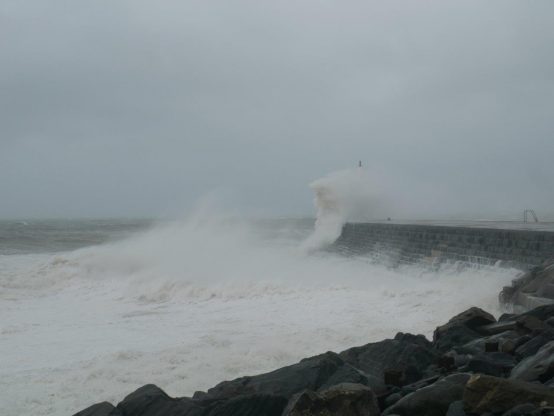
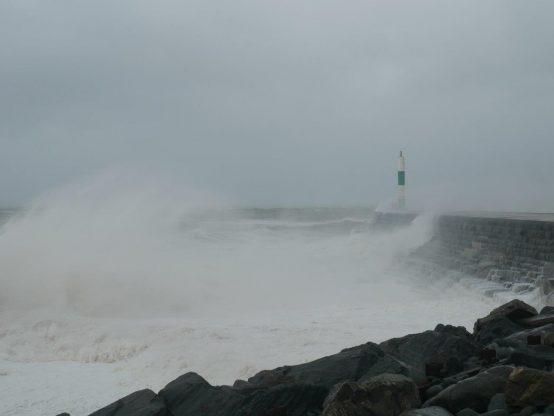
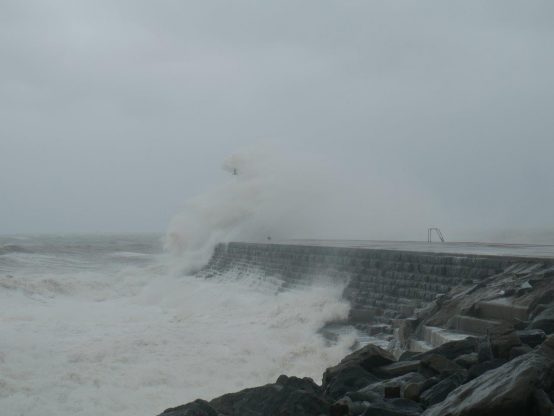
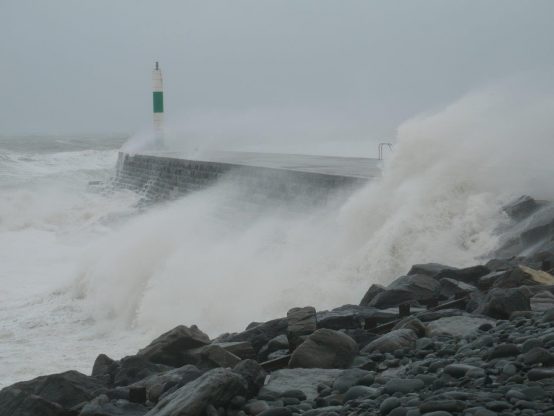
Waves breaking over the stone jetty
The town is a little tamer than Tanybwlch, but still dramatic. At 4pm the clouds were so dark that the streetlights on the prom were glimmering into light.
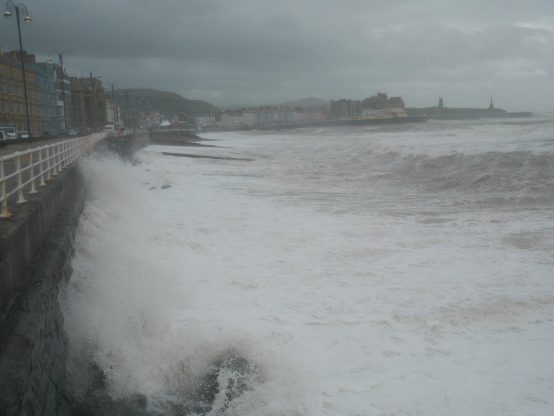
The Promenade takes a battering
Unwary promenaders could get splashed by the waves curling up against the sea wall and showering spray and small pieces of gravel. As the waves pull back the perfect profile of the sandy beach is briefly exposed.
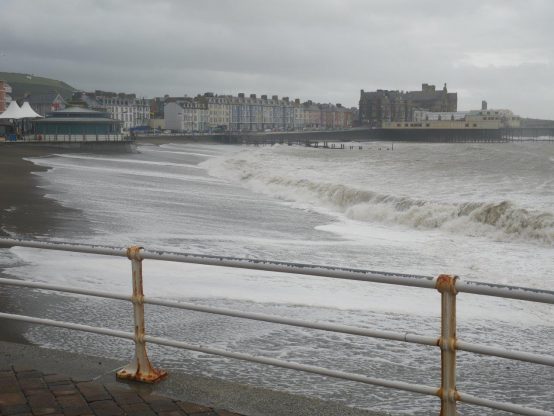
Sand is smoothed out as the big waves flow back into the sea
The full force of the open sea is greatest at Alexandra Hall but this was a summer storm, not one of the ferocious winter ones which sometimes hurl stones at the windows of that forbidding building. The door was open and without barricades. Students will soon be moving in again. There were a few walkers kicking the bar, and beyond it the small piece of sandy beach below Constitution Hill was white with blown sea foam.
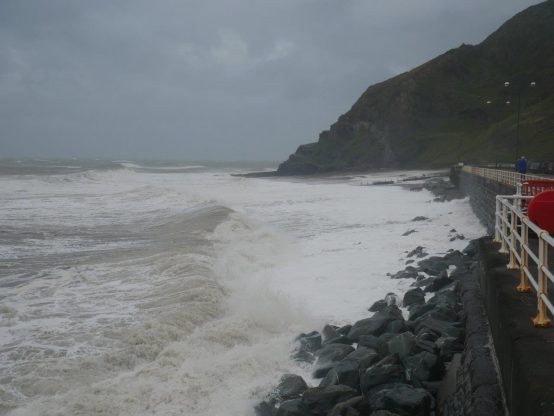
The north end of the beach
I came home to wash the sea salt out of my hair, much invigorated by the wind and waves.
Covid instruction fatigue
by the Curious Scribbler
I went into Argos today to collect a purchase made online. The store was perfectly empty of customers, and a young woman at the door directed me to a young man at the right hand end of the counter. Separating him from me was a broad no man’s land of diagonally placed yellow tape on the floor, a no go zone reaching six feet from the counter. Standing obediently outside this forbidden zone I began to state my business. But this was not good enough. I was instructed to move to the left and stand with my feet upon the two footprints in a red box before my order number could be processed! I then progressed to a second red box marked with two footprints order to receive my order. Am I alone in suffering from instruction fatigue?
At Westonbury Water Gardens, near Presteigne last week, I and my companions obediently followed the one way system around the garden. It was disappointing that the eccentric water-powered cuckoo clock has been disabled for the pandemic. But we were really nonplussed by the instructions at the approach to the toilets. On a table outside we found instructions to use hand sanitizer and don the provided blue nitrile gloves before entering, then to discard the gloves in the bin provided on leaving. Once inside, one was faced with a dilemma: wash the gloves, or remove the gloves and wash the hands? And there being no hot air hand driers to blow virus particles around the room, how to refit the gloves upon wet hands? In the end I came away with washed hands and the gloves – which may come in handy some time.
At Lower Brockhampton Park, we had to pay online for timed entry to the National Trust grounds and arrive in our half hour slot, or not at all. While this laudably limited the number of people in the outdoor setting, and understandably denied access to the house, we also found that many of the paths leading to attractive features had been roped off, and found ourselves instead on a muddy track leading nowhere interesting. Could we not have been trusted to socially distance ourselves out of doors?
In Llanidloes Church I had hoped to view the 13th Century arcade rescued from from Cwmhir Abbey after the Dissolution and was encouraged by the sight of an open church door. Sadly we found just the porch was open, adorned with origami doves and a plethora of notices!
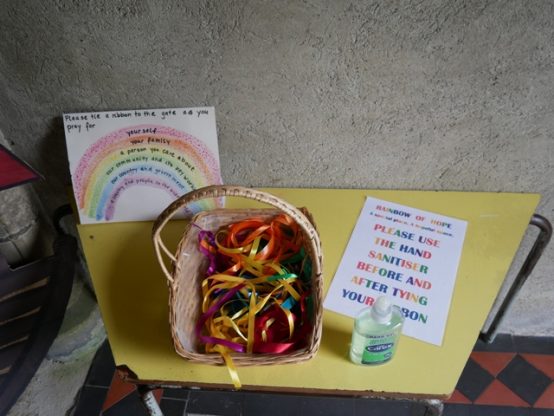
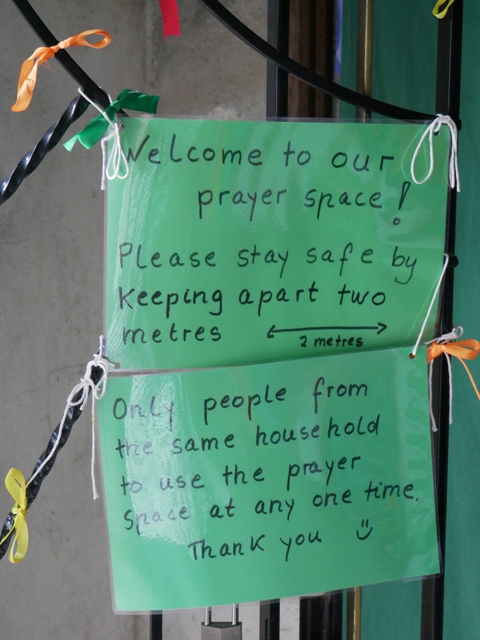
The church seems to be taking an especially discouraging approach to re-opening, in spite of Welsh government permission to do so. Other than when services are scheduled it is rare indeed for a random church visitor to find another person already present in an average parish church. Surely one admonitory notice and a bottle of hand sanitiser would suffice here?
These small but baffling restrictions are disruptive. I am minded to only to frequent places where there is absolutely no one to tell me how to behave. In this respect a weekend outing to Clywedog Reservoir ticked all the boxes! First we parked at the Bryntail Lead Mine car park below the 100 foot dam. Respectfully passing a few other tourists, we walked across the footbridge, and passed through a metal gate to visit the ruined mine buildings.
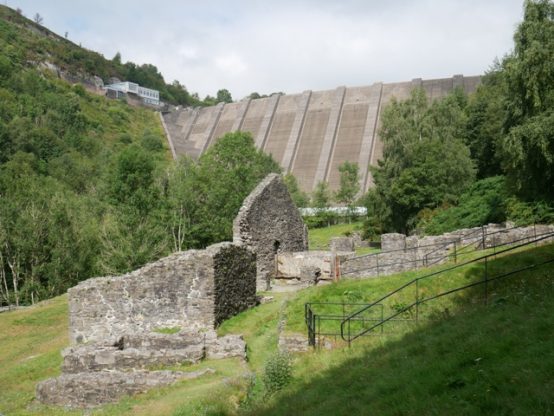
Bryntail lead and barytes mine works
The only admonishment came from that wonderful cast iron Cadw warning which displays people falling over around a variety of obstacles, overhead or underfoot. (Should the central picture be re-interpreted as a warning to avoid a person with a headache and a sneeze?)
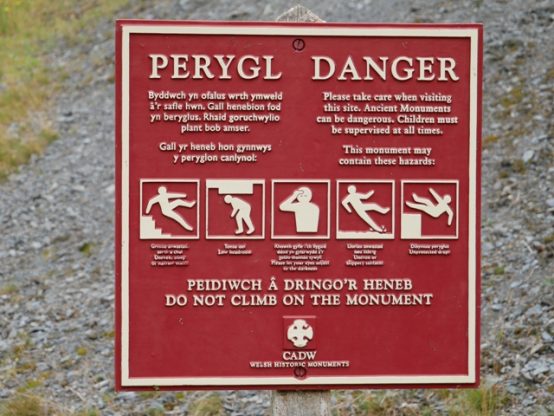
The Cadw warning sign is an artwork in its own right
Climbing a path from the mine ruins we rose through dunnock-infested bracken and gorse to above dam level and were rewarded with the sight of cormorants wheeling on straight wings high overhead. They look extraordinarily prehistoric circling on high, instead of flapping industriously over the sea as one usually sees them.
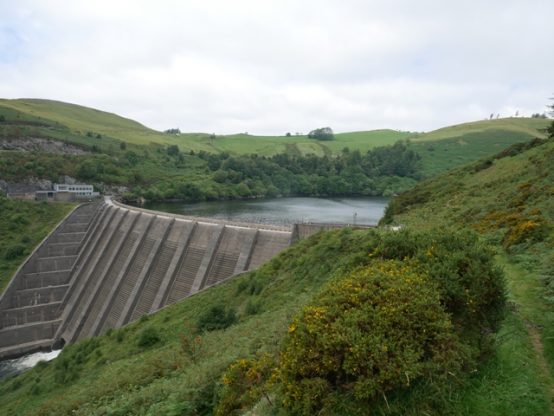
Clywedog reservoir
Later we drove along the western side of the reservoir, and picnicked on the grass. At the head of the reservoir we stopped to view the Clywedog ospreys’ breeding tree and the two fledged youngsters perching grumpily in nearby conifers. No adult brought them fish. Later, we read that a Clywedog osprey had chosen to take that day off to visit their colleagues on the Dyfi Estuary.
The return to Aberystwyth via the mountain road to Machynlleth was uplifting, with another pause to gaze down the spectacular river-cut gorge at Dylife to the U shaped valley beyond. The Cambrian mountains were sculpted by the last ice age. They may be lower than Snowdonia, but they offer space and tranquillity and a reassuring absence of rules. I think we passed three cars on the way.
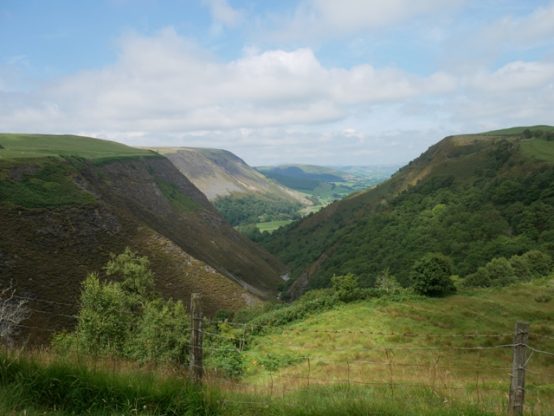
The Dylife Gorge
The Palaeontologists of Llandrindod Wells
by The Curious Scribbler
The most remarkable people conceal themselves in the Welsh hills. Today’s exhibit are Cambridge-educated palaeontologists Joe Botting and Lucy Muir whose home is in Llandrindod Wells. As independent researchers they work all over the world, currently in China, the Czech Republic and Morocco and are among the foremost experts on Cambrian fossil communities – animals which lived at least 500 million years ago.

It was the Ordovician rocks of central Wales which brought them to Llandrindod Wells, and their research is putting their home town on the map. To the untrained eye the local stone look pretty unexciting, grey and shaley, and there is absolutely no chance of spotting a dinosaur bone or a nice big ammonite for the mantelpiece. Most amateurs would be proud enough to find a fossil trilobite, a segmented arthropod of a kind which became extinct 300 million years ago. This creature had a rigid carapace which formed a mould in the sediment and was thus more readily preserved as a fossil.
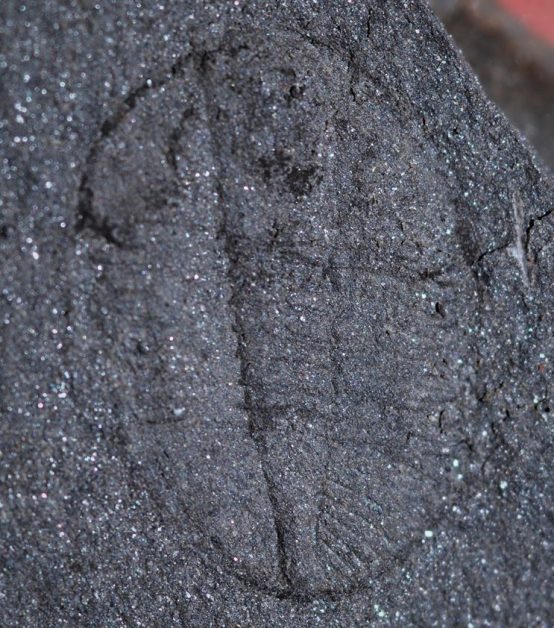
A trilobite from Llandrinod Wells (Ogyginus corndensis)
But very close inspection in the right places has revealed an unguessed-at variety of tiny fossils whose soft bodies are preserved as little more that smears between the layers of flaking grey rock.
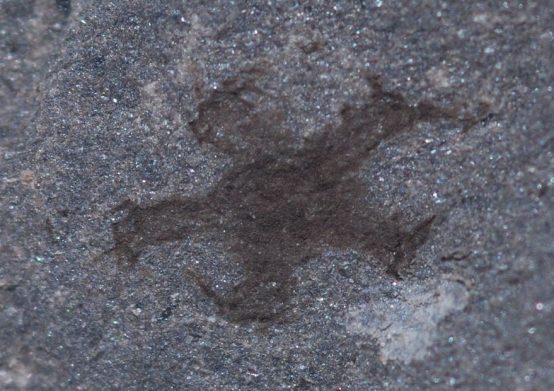
A tiny starfish just 2mm across.
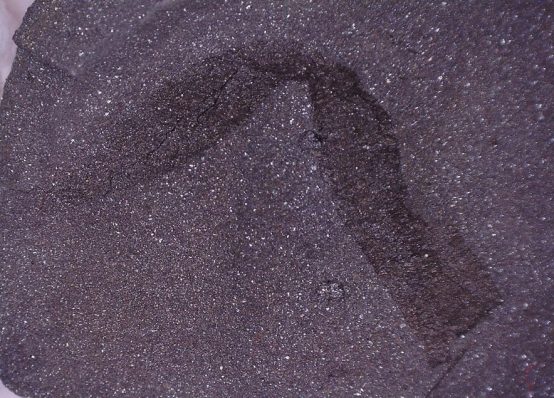
A palaeoscolecid worm with microscopically armoured skin that is exquisitely beautiful under high magnification.
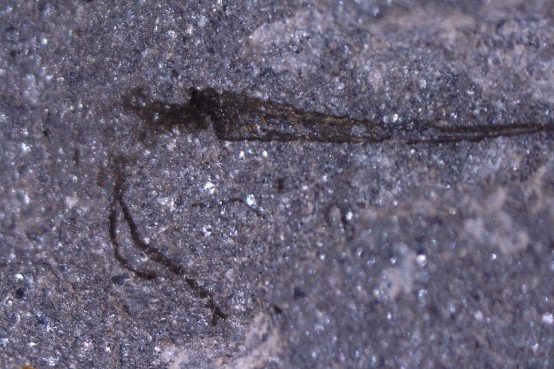
An as yet unnamed creature which has tentacles
Joe and Lucy’s discoveries present a picture of an ocean teaming with life 450 million years ago. Hours and hours of collecting, inspecting shards of rock for any tell tale sign of a fossil must be followed by days of microscopic study, to identify and photograph these tiny traces. Important publications will follow. It is for this reason that they have launched a crowdfunding page to buy a high quality binocular microscope and digital camera set-up to be installed at their home in Llandrindod Wells.
Life is precarious for independent researchers: Joe busks in the summer and Lucy does part time editing to support their modest life needs. They welcome amateur enthusiasts and have already been pivotal in launching at least one Penglais pupil on his geological career. In Llandrindod, they run a local amateur fossil group, provide public talks and workshops, visit local primary schools, and run field trips. They are involved in the community orchard, the repair shop, and the Transition Towns Group. As they say “We even offer our personal space, time and equipment to anyone who has need of it, simply to encourage a love of the natural sciences.”
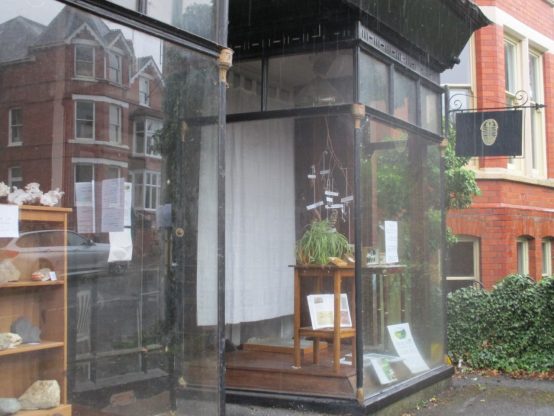
At the Sign of the Trilobite
The high quality photo microscope would be installed at their premises and will be of equal benefit to other scientists, especially in fields such as botany, insects, or archaeology, who will be able to use it free by appointment. Donations in the first week of the appeal have exceeded £5000 but there is more to go for a first rate piece of kit. Go to their web page and read all about it!
https://www.gofundme.com/f/a-microscope-for-amateur-science-in-wales
Upfest at Tanybwlch?
by The Curious Scribbler
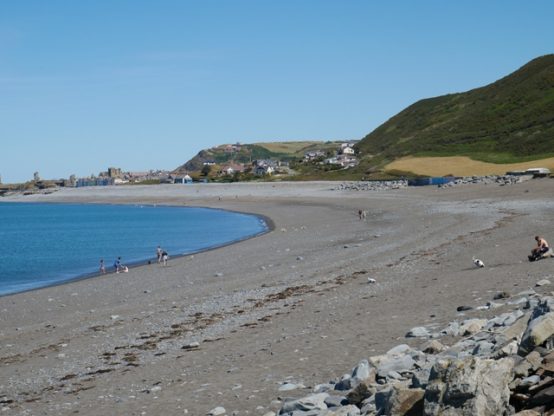
Tanybwlch beach, looking north to Aberystwyth
Inspired by the video I described in the preceding blog, I walked Tanybwlch beach again yesterday, enjoying the blazing sun and balmy breeze. The sea was almost waveless, clear and the deepest blue, and the shore, as usual, was almost deserted. I saw a family at the water’s edge, and a couple of people walking their dogs, and I passed one man who was seated watching his three terriers each of which was energetically digging its own hole in the sand. The sea, cracked only by a single ripple approaching the shore, looked like shot silk.
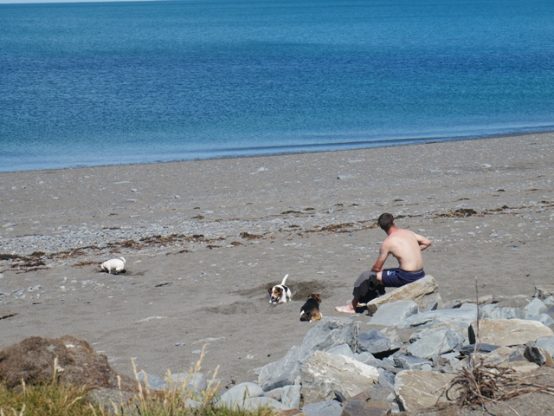
Three digging dogs
The graffiti artists on the concrete sea wall have been back and have further embellished the design which appeared on the drone video I had watched. The letters NHS are no longer brutalist boxy letters, now sporting serifs and curliques of a playful nature. The seated figure, on closer inspection, is a dead-eyed Boris debating whether or whether not to save the NHS. To the right are a series of weird heads, two gowned and masked blue front-liners, and then a group perhaps the public, some in outline, one with a covid mask. There is more wall yet to be painted, I think there is more work to be done there.
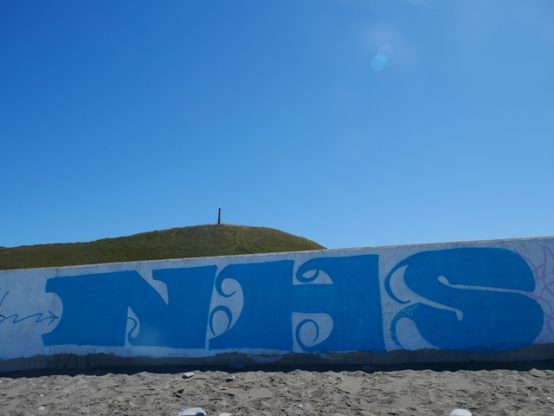
Graffiti at Tanybwlch beach
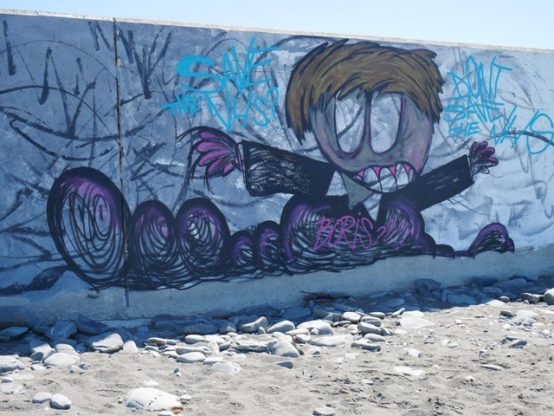
Graffiti at Tanybwlch beach
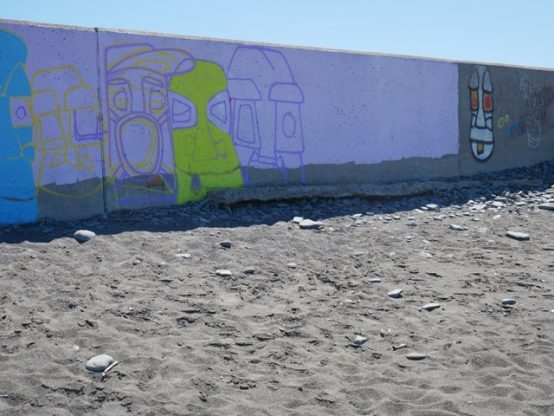
The right-hand end of the mural, yet to be coloured in?
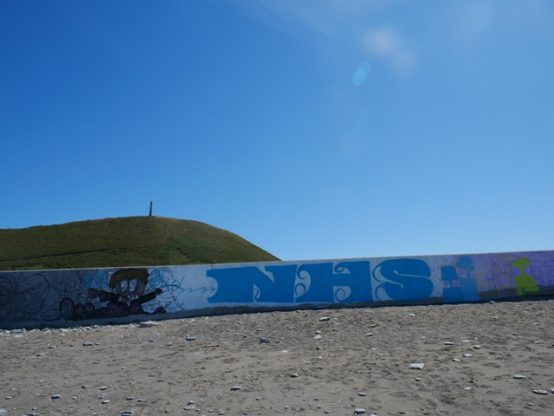
The whole mural at Tanybwlch beach, possibly yet to be completed
It seems surprising now, that no-one has formerly set about embellishing this long wall. Here is a canvas comparable with some of the large murals created for the Upfest Festival in Bristol, and like many of those, it is on a topical theme. I have just noticed that the latest Upfest, which brings together British and international artists, was scheduled to take place this weekend, 30 May- 1 June 2020. I presume that like everything else, it has been postponed, though this is not confirmed on their website.
This blog has previously reported from Upfest, and I hope to go again.
Tanybwlch – A Historic Video
by The Curious Scribbler
Day 67 of lockdown – the days have become a bit of a blur. Like a soothing nature programme, the past two months have been generally beautiful, with startlingly clear skies, lovely wildflowers, continuous birdsong. Too continuous even, I sometimes wish that the monotonous chiffchaffs would give it a rest.
My walks start from my front door, and lead me to Tanybwlch beach, Pendinas, Penparcau and Llanfarian along the footpaths and cycle paths. I am so fortunate to have such an amazing landscape within easy reach. Today I found a newly posted video on You Tube named Aberystwyth in the SKY Tan Y Bwlch which gave me great delight. Here is a tranquil 4 minutes of a birds-eye view of my entire domain, shot during lockdown on one of the many still days when the sea barely sucks at the shore, the sun blazes down, and people, so few and far between, are visible here and there. There are no cars in the Tanybwlch car park (a consequence of the concrete roadblock erected in late March), no contrails in the sky. We may look back with nostalgia on this creepily empty scene when normal life is resumed.
I am pleased that the photographer has briefly included a child and a dog, (presumably his or her own) enjoying the shore. Children have been out and about far too little during lockdown. Joggers and cyclists have made the most of their freedoms, but to spy a child has been a rare sight on my walks. Hopefully today’s announcement will empower more families to take their children out on our beaches.
At the very end of the film is the briefest glimpse of a huge new graffito on the concrete barrage where the Ystwyth turns northwards. The brutalist blue capitals contrast with the human depicted on the left, a figure more typical of the ethos of the beach.
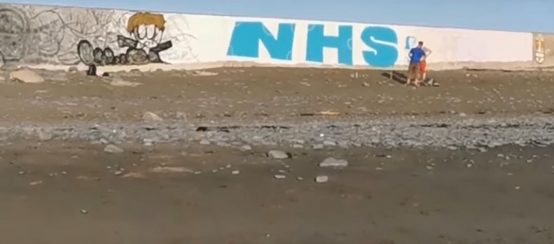
A screen grab from the video
It would be very visible from the sea: were anyone out there to view it.
Footpath is open at Penparcau
By The Curious Scribbler
I am delighted to learn that I am in error, and that last week I quite needlessly climbed over a gate ( as described in yesterday’s blog). The gate in question was on the footpath across the flank of Pendinas, which emerges at the Cae Job gate to Penparcau.
I had let myself through the gate on Felin y Mor and onto the seaward end of the path, by means of lifting the little latch on the gate with my gloved hand, in accordance with best practice. At the Cae Job gate I failed to open it, and finding the latch immobilized with a cable tie, I believed it to be locked. Several readers have today informed me that the cable tie in fact immobilized the catch in the open position!
I am grateful to learn this and hope others will not be discouraged from taking the path. The purpose of the cable tie, I learn, was to allow the gate to open at a push (or a pull), without need to touch it. I don’t know why it didn’t then swing open when I began to climb it, but the good news is that the path is not closed. The route through the fragrant gorse, with its attendant stonechats, chiffchaffs, dunnocks, linnets and wrens is a delight. Violets, primroses and stitchwort flank the path, and a thirsty dog can pause at the well beside the ruined remains of the cottage which formerly stood on the long slope towards the sea.
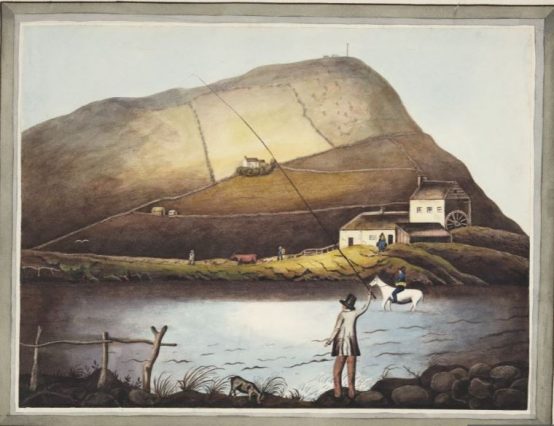
‘The Welsh Primitive’ (active 1830-1853) painted the cottage beside the path, half way up Pendinas. National Library of Wales, Drawing Volume 56.
I find that a massive 1400 people read yesterday’s Letter from Aberystwyth, when it was flagged up in the You Know You’re from Aberystwyth When group on Facebook, and the comments there were many and varied. Some feel as I do, while others feel that I should stay home and shut up! A disputed theme concerns the blocking of car parks such as that at Tanybwlch beach. Last week, the Government clarified that it was acceptable to drive locally to access a suitable place to walk: the guidance being that one should not drive long distances to take a short walk. It remains the case that at present many people feel intimidated to travel even a mile by car to enable them to walk safely in an agreeable open space. I am indeed fortunate to have all this landscape within walking distance from my home.

